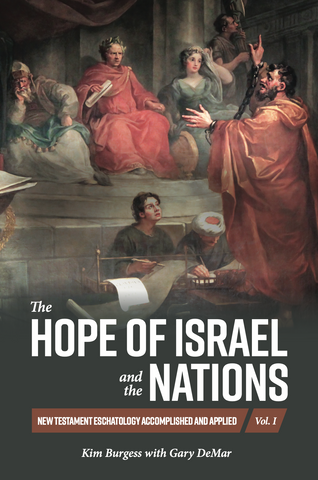Bible Prophecy Under the Microscope-Episode 60
Gary continues his response to Amir Tsarfati, who tried to take Kirk Cameron to task for comments he made about Israel.
The restoration of Israel involved a transformation or change in the form that Israel was to take under the coming New Covenant order. In Episode 7, we looked at passages like Isaiah 49:5-6, Acts 15:16-17, and Romans 15:8-13 where the salvation-blessings for the Gentile nations were fulfilling the promises made to Abraham, Isaac, and Jacob in what the New Testament calls the restoration of Israel. Let’s continue by looking at Hebrews 9:6-10 and Acts 3:19-21 to show how they are all linked. The key principle is found in Hebrews 9:8:
The Holy Spirit is signifying this, that the way into the holy place has not yet been disclosed, while the outer [lit., first] tabernacle is still standing.
In context, the writer (I believe that Apollos wrote the epistle to the Hebrews) describes the two-part structure of the tabernacle. He is deliberately calling it a “tabernacle” because a tabernacle is not something that is structurally permanent. It is a “tent” as opposed to a permanent building, symbolic of the fact the Old Covenant order was not intended to last; it was only for a specific temporary period in Israel’s redemptive history until the Christ came, that is, “the Seed to whom the promise had been made” (Gal. 3:19). Apollos describes the contents or the furnishings in the two tents that made up this tabernacle. It is insightful that he calls the “first” tent the “outer” tabernacle, thereby implying that the “second” tent is the “inner” one. Now we understand what he means by this. The first or the outer tent would be what we would call “the Holy Place,” whereas the second or the inner tent is what we know of “the Holy of Holies.” But the intriguing thing here is that Hebrews 9:8 is a blockbuster verse for what it declares eschatologically, though, admittedly, the declaration is couched or stated in symbolic or figurative language. But, figurative or not, it is very important.
Apollos writes, the Holy Spirit signifies that the way into the Holy of Holies, that is, into the second or the inner tent, has not yet been disclosed while or as long as the outer or the first tent is still standing. What does this mean? He is saying that the Old Covenant tabernacle was designed by God with these two parts for an important reason. The outer or the first tent represents the Old Covenant order itself, whereas the inner or the second tent, that is, the Holy of Holies, represents the New Covenant order! But what is the eschatological point being made? The New Covenant order could not and would not be fully in place, established and ready to go, unless and until the prior Old Covenant order was fully removed, historically and visibly. This means that, vastly important as all these events surely were, it took more than the cross, the resurrection, the ascension of Christ, and Pentecost to accomplish this covenantal transition. It also took the necessary historical and visible redemptive events of AD 70 where the Old Covenant order, with the destruction of the Old Covenant or Mosaic temple, ceased to exist and function in history.

The Hope of Israel and the Nations
The reader and student of the Bible must first understand the content of the New Testament writings in terms of how those in the first century would have understood it. The New Testament is written against the background of the Old Testament. The shadows of the Old were fulfilled in the reality of the New. All the rituals and ceremonies were fulfilled in Jesus. The same is true of the temple, land, blood sacrifices, the nature of redemption, the resurrection of the dead, the breaking down of the dividing wall dividing Jews and Gentiles, and so much more. The New Testament's emphasis is on the finished work of Jesus and its application, not only to that Apostolic generation but to the world today.
Buy NowGary continues his response to Amir Tsarfati, who tried to take Kirk Cameron to task for comments he made about Israel. Gary shows how inconsistent, ahistorical, and unbiblical Tsarfati’s view of Bible prophecy really is. It is nothing more than repackaged information from many other dispensational speculators over the last 50 years.
Click here for today’s episode
Click here for all episodes of Bible Prophecy Under the Microscope

